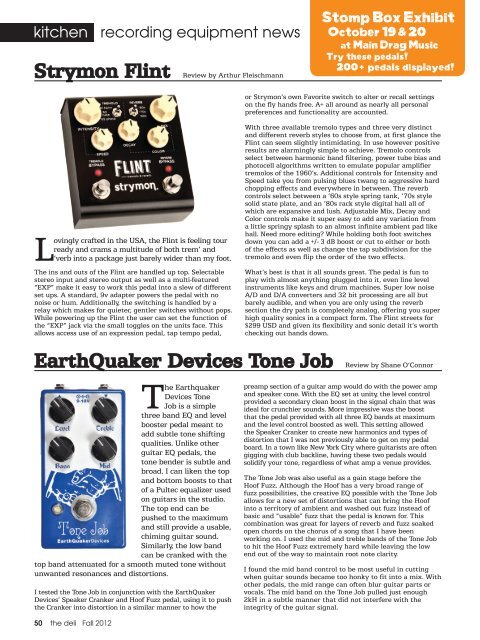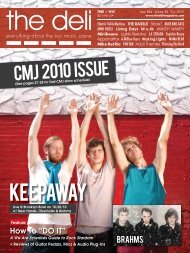You also want an ePaper? Increase the reach of your titles
YUMPU automatically turns print PDFs into web optimized ePapers that Google loves.
kitchen recording equipment news<br />
Strymon Flint Review by Arthur Fleischmann<br />
Stomp Box Exhibit<br />
October 19&20<br />
at Main Drag Music<br />
Try these pedals!<br />
200 + pedals displayed!<br />
or Strymon’s own Favorite switch to alter or recall settings<br />
on the fly hands free. A+ all around as nearly all personal<br />
preferences and functionality are accounted.<br />
Lovingly crafted in the USA, the Flint is feeling tour<br />
ready and crams a multitude of both trem’ and<br />
‘verb into a package just barely wider than my foot.<br />
<strong>The</strong> ins and outs of the Flint are handled up top. Selectable<br />
stereo input and stereo output as well as a multi-featured<br />
“EXP” make it easy to work this pedal into a slew of different<br />
set ups. A standard, 9v adapter powers the pedal with no<br />
noise or hum. Additionally, the switching is handled by a<br />
relay which makes for quieter, gentler switches without pops.<br />
While powering up the Flint the user can set the function of<br />
the “EXP” jack via the small toggles on the units face. This<br />
allows access use of an expression pedal, tap tempo pedal,<br />
With three available tremolo types and three very distinct<br />
and different reverb styles to choose from, at first glance the<br />
Flint can seem slightly intimidating. In use however positive<br />
results are alarmingly simple to achieve. Tremolo controls<br />
select between harmonic band filtering, power tube bias and<br />
photocell algorithms written to emulate popular amplifier<br />
tremolos of the 1960’s. Additional controls for Intensity and<br />
Speed take you from pulsing blues twang to aggressive hard<br />
chopping effects and everywhere in between. <strong>The</strong> reverb<br />
controls select between a ’60s style spring tank, ’70s style<br />
solid state plate, and an ’80s rack style digital hall all of<br />
which are expansive and lush. Adjustable Mix, Decay and<br />
Color controls make it super easy to add any variation from<br />
a little springy splash to an almost infinite ambient pad like<br />
hall. Need more editing? While holding both foot switches<br />
down you can add a +/- 3 dB boost or cut to either or both<br />
of the effects as well as change the tap subdivision for the<br />
tremolo and even flip the order of the two effects.<br />
What’s best is that it all sounds great. <strong>The</strong> pedal is fun to<br />
play with almost anything plugged into it, even line level<br />
instruments like keys and drum machines. Super low noise<br />
A/D and D/A converters and 32 bit processing are all but<br />
barely audible, and when you are only using the reverb<br />
section the dry path is completely analog, offering you super<br />
high quality sonics in a compact form. <strong>The</strong> Flint streets for<br />
$299 USD and given its flexibility and sonic detail it’s worth<br />
checking out hands down.<br />
EarthQuaker Devices Tone Job Review by Shane O’Connor<br />
<strong>The</strong> Earthquaker<br />
Devices Tone<br />
Job is a simple<br />
three band EQ and level<br />
booster pedal meant to<br />
add subtle tone shifting<br />
qualities. Unlike other<br />
guitar EQ pedals, the<br />
tone bender is subtle and<br />
broad. I can liken the top<br />
and bottom boosts to that<br />
of a Pultec equalizer used<br />
on guitars in the studio.<br />
<strong>The</strong> top end can be<br />
pushed to the maximum<br />
and still provide a usable,<br />
chiming guitar sound.<br />
Similarly, the low band<br />
can be cranked with the<br />
top band attenuated for a smooth muted tone without<br />
unwanted resonances and distortions.<br />
I tested the Tone Job in conjunction with the EarthQuaker<br />
Devices’ Speaker Cranker and Hoof Fuzz pedal, using it to push<br />
the Cranker into distortion in a similar manner to how the<br />
preamp section of a guitar amp would do with the power amp<br />
and speaker cone. With the EQ set at unity, the level control<br />
provided a secondary clean boost in the signal chain that was<br />
ideal for crunchier sounds. More impressive was the boost<br />
that the pedal provided with all three EQ bands at maximum<br />
and the level control boosted as well. This setting allowed<br />
the Speaker Cranker to create new harmonics and types of<br />
distortion that I was not previously able to get on my pedal<br />
board. In a town like New York City where guitarists are often<br />
gigging with club backline, having these two pedals would<br />
solidify your tone, regardless of what amp a venue provides.<br />
<strong>The</strong> Tone Job was also useful as a gain stage before the<br />
Hoof Fuzz. Although the Hoof has a very broad range of<br />
fuzz possibilities, the creative EQ possible with the Tone Job<br />
allows for a new set of distortions that can bring the Hoof<br />
into a territory of ambient and washed out fuzz instead of<br />
basic and “usable” fuzz that the pedal is known for. This<br />
combination was great for layers of reverb and fuzz soaked<br />
open chords on the chorus of a song that I have been<br />
working on. I used the mid and treble bands of the Tone Job<br />
to hit the Hoof Fuzz extremely hard while leaving the low<br />
end out of the way to maintain root note clarity.<br />
I found the mid band control to be most useful in cutting<br />
when guitar sounds became too honky to fit into a mix. With<br />
other pedals, the mid range can often blur guitar parts or<br />
vocals. <strong>The</strong> mid band on the Tone Job pulled just enough<br />
2kH in a subtle manner that did not interfere with the<br />
integrity of the guitar signal.<br />
50 the deli Fall <strong>2012</strong>







